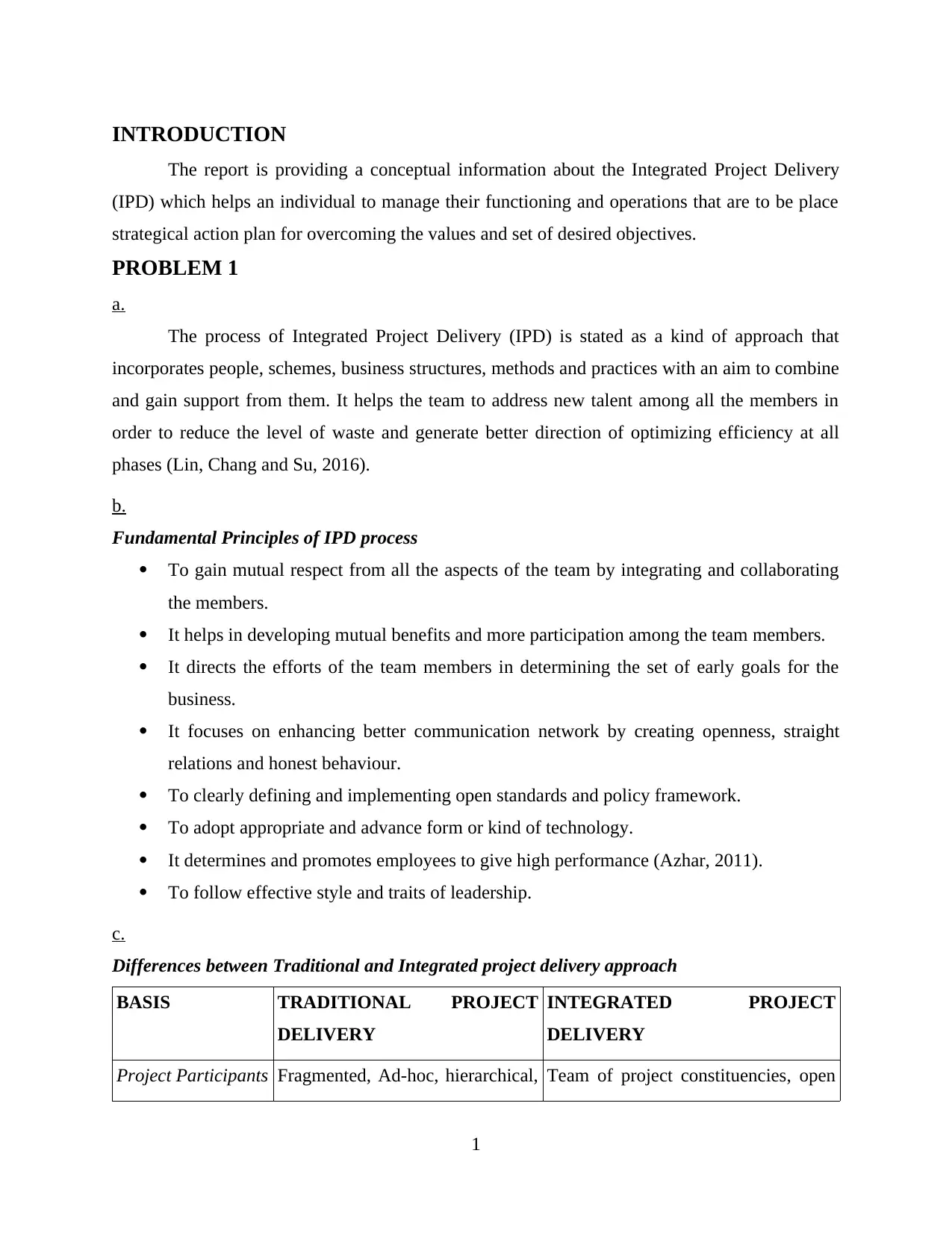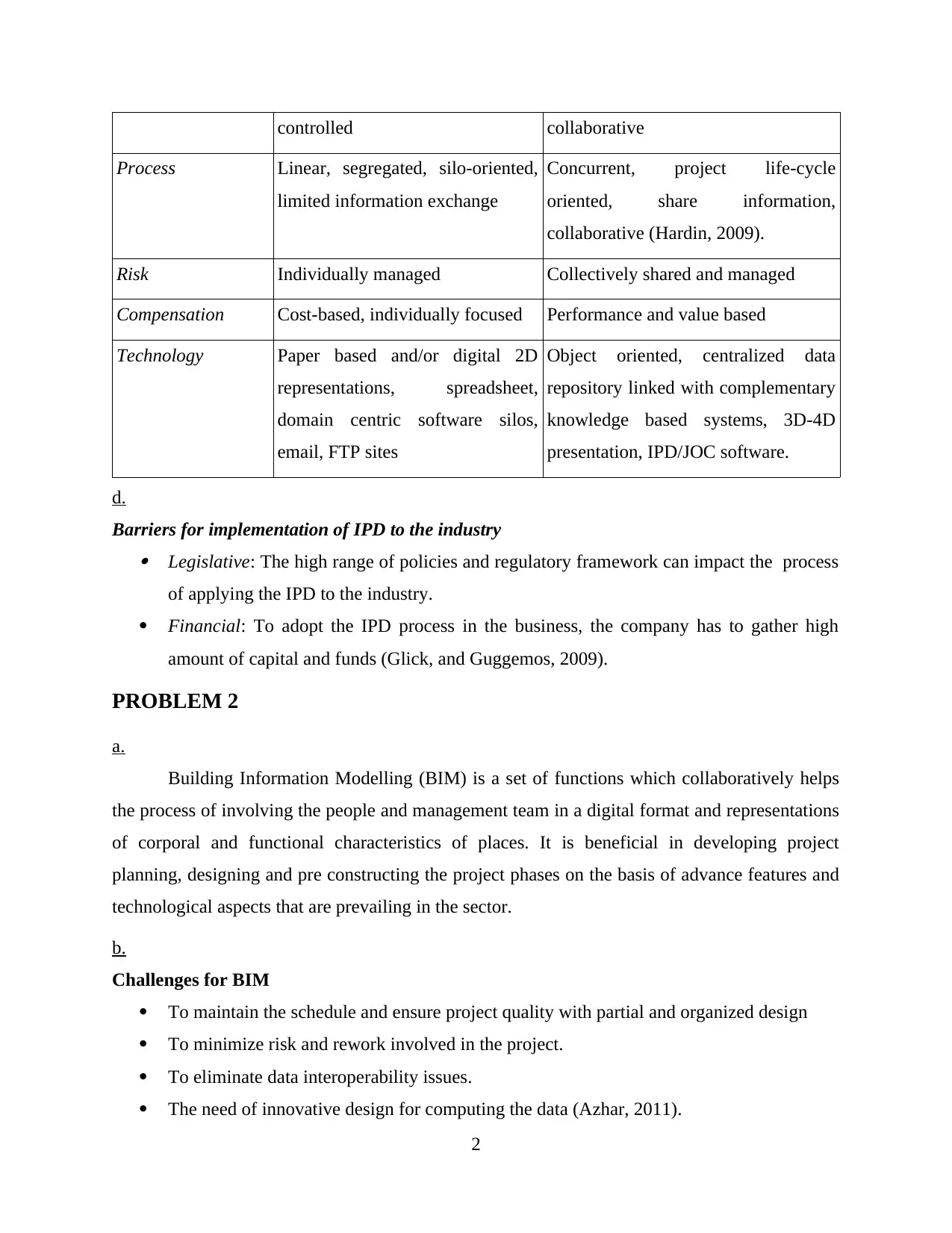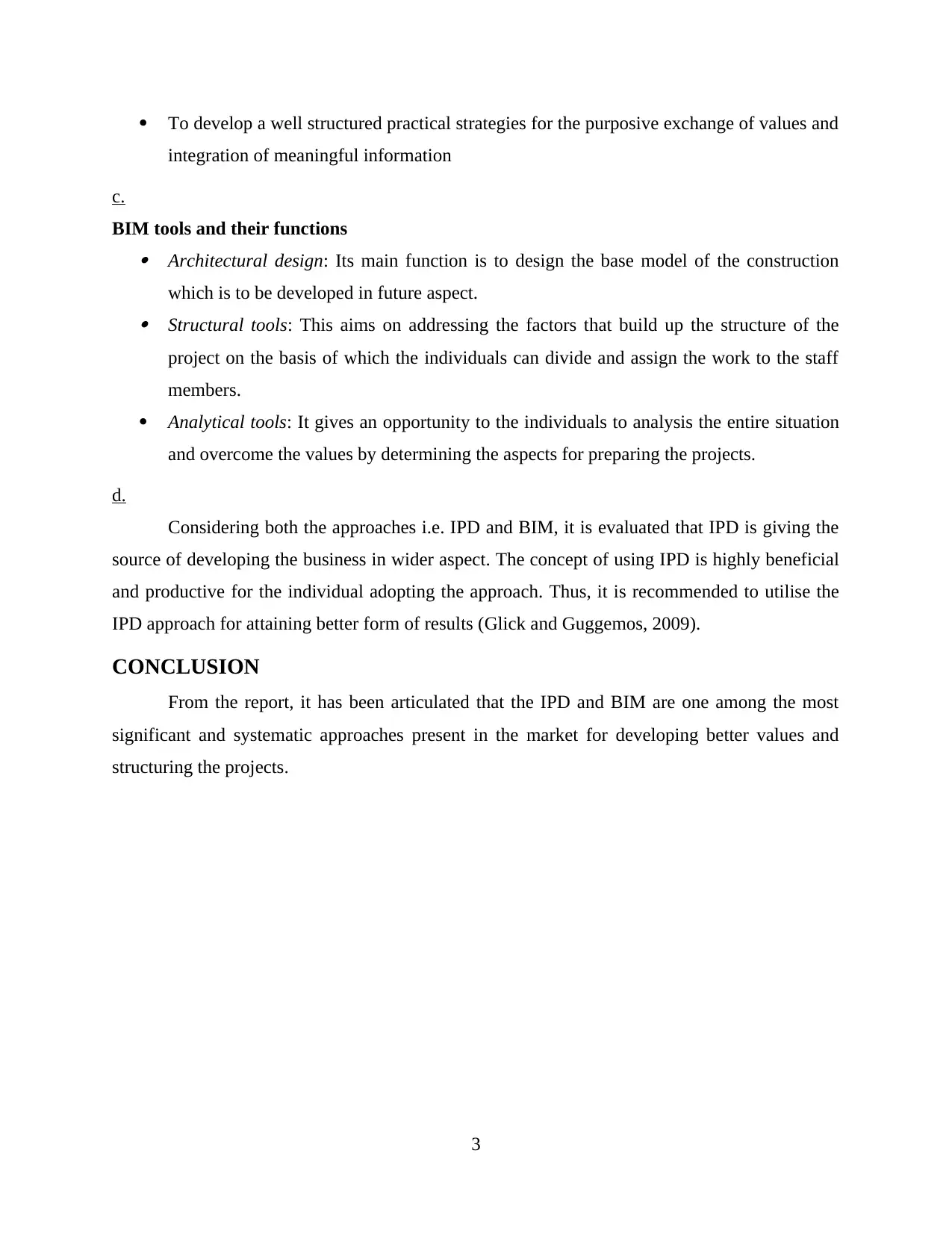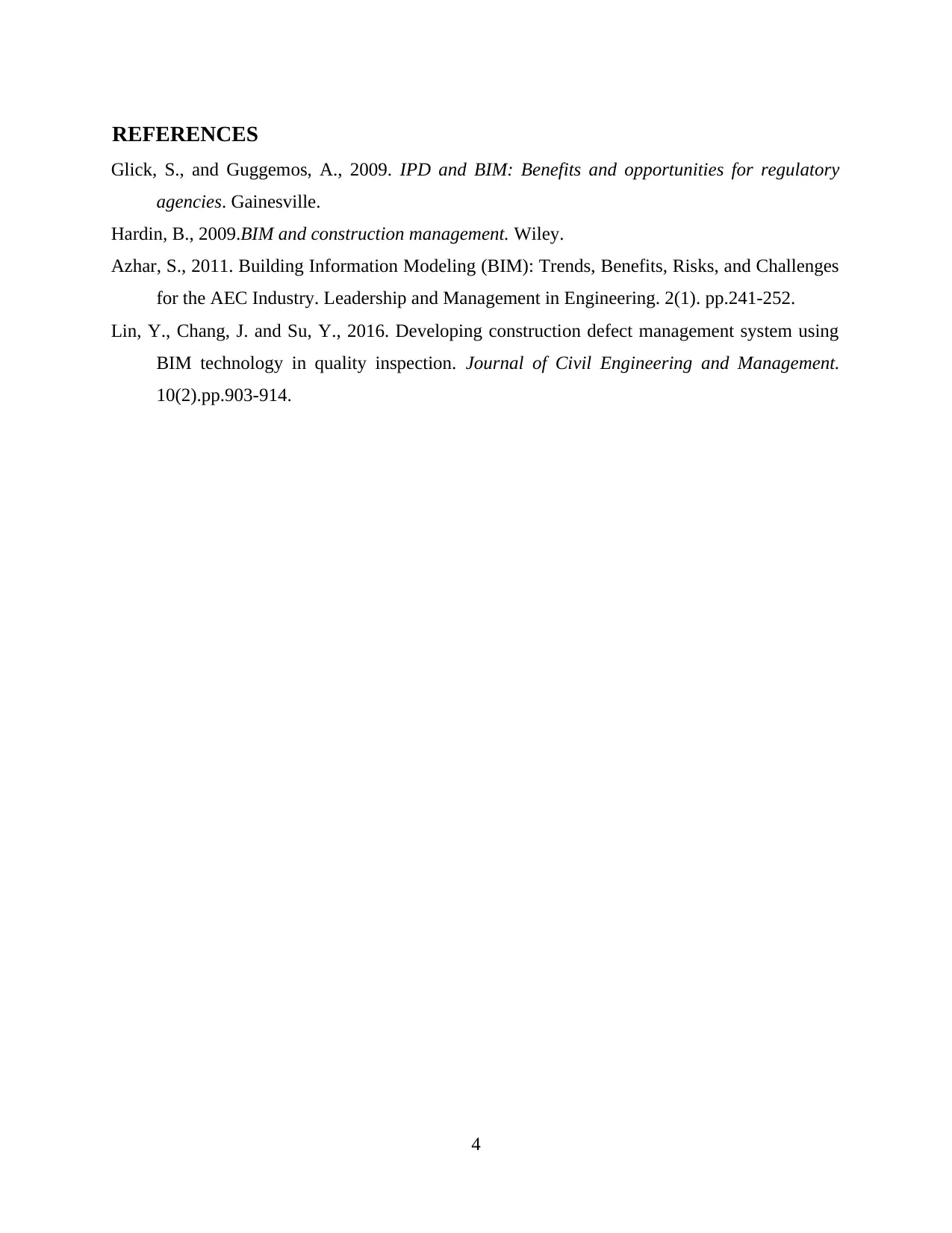Business Development Project: IPD and BIM Implementation Analysis
VerifiedAdded on 2020/01/07
|6
|951
|349
Report
AI Summary
This report provides a conceptual overview of Integrated Project Delivery (IPD) and Building Information Modeling (BIM) and their application in project management. It explores the IPD process, its fundamental principles, and differences compared to traditional project delivery, as well as the barriers to its implementation. The report also discusses Building Information Modeling (BIM), its challenges, and various BIM tools like architectural and structural design tools, and analytical tools. The analysis concludes that IPD is highly beneficial and productive for business development and recommends its utilization for better project results, emphasizing the systematic approaches of IPD and BIM in structuring projects for improved values.

PROJECT
MANAGEMENT
MANAGEMENT
Paraphrase This Document
Need a fresh take? Get an instant paraphrase of this document with our AI Paraphraser

TABLE OF CONTENTS
INTRODUCTION ..........................................................................................................................1
PROBLEM 1....................................................................................................................................1
a...................................................................................................................................................1
b...................................................................................................................................................1
c...................................................................................................................................................1
d...................................................................................................................................................2
PROBLEM 2....................................................................................................................................2
a...................................................................................................................................................2
b...................................................................................................................................................2
c...................................................................................................................................................3
d...................................................................................................................................................3
CONCLUSION................................................................................................................................3
REFERENCES................................................................................................................................4
INTRODUCTION ..........................................................................................................................1
PROBLEM 1....................................................................................................................................1
a...................................................................................................................................................1
b...................................................................................................................................................1
c...................................................................................................................................................1
d...................................................................................................................................................2
PROBLEM 2....................................................................................................................................2
a...................................................................................................................................................2
b...................................................................................................................................................2
c...................................................................................................................................................3
d...................................................................................................................................................3
CONCLUSION................................................................................................................................3
REFERENCES................................................................................................................................4

INTRODUCTION
The report is providing a conceptual information about the Integrated Project Delivery
(IPD) which helps an individual to manage their functioning and operations that are to be place
strategical action plan for overcoming the values and set of desired objectives.
PROBLEM 1
a.
The process of Integrated Project Delivery (IPD) is stated as a kind of approach that
incorporates people, schemes, business structures, methods and practices with an aim to combine
and gain support from them. It helps the team to address new talent among all the members in
order to reduce the level of waste and generate better direction of optimizing efficiency at all
phases (Lin, Chang and Su, 2016).
b.
Fundamental Principles of IPD process
To gain mutual respect from all the aspects of the team by integrating and collaborating
the members.
It helps in developing mutual benefits and more participation among the team members.
It directs the efforts of the team members in determining the set of early goals for the
business.
It focuses on enhancing better communication network by creating openness, straight
relations and honest behaviour.
To clearly defining and implementing open standards and policy framework.
To adopt appropriate and advance form or kind of technology.
It determines and promotes employees to give high performance (Azhar, 2011).
To follow effective style and traits of leadership.
c.
Differences between Traditional and Integrated project delivery approach
BASIS TRADITIONAL PROJECT
DELIVERY
INTEGRATED PROJECT
DELIVERY
Project Participants Fragmented, Ad-hoc, hierarchical, Team of project constituencies, open
1
The report is providing a conceptual information about the Integrated Project Delivery
(IPD) which helps an individual to manage their functioning and operations that are to be place
strategical action plan for overcoming the values and set of desired objectives.
PROBLEM 1
a.
The process of Integrated Project Delivery (IPD) is stated as a kind of approach that
incorporates people, schemes, business structures, methods and practices with an aim to combine
and gain support from them. It helps the team to address new talent among all the members in
order to reduce the level of waste and generate better direction of optimizing efficiency at all
phases (Lin, Chang and Su, 2016).
b.
Fundamental Principles of IPD process
To gain mutual respect from all the aspects of the team by integrating and collaborating
the members.
It helps in developing mutual benefits and more participation among the team members.
It directs the efforts of the team members in determining the set of early goals for the
business.
It focuses on enhancing better communication network by creating openness, straight
relations and honest behaviour.
To clearly defining and implementing open standards and policy framework.
To adopt appropriate and advance form or kind of technology.
It determines and promotes employees to give high performance (Azhar, 2011).
To follow effective style and traits of leadership.
c.
Differences between Traditional and Integrated project delivery approach
BASIS TRADITIONAL PROJECT
DELIVERY
INTEGRATED PROJECT
DELIVERY
Project Participants Fragmented, Ad-hoc, hierarchical, Team of project constituencies, open
1
⊘ This is a preview!⊘
Do you want full access?
Subscribe today to unlock all pages.

Trusted by 1+ million students worldwide

controlled collaborative
Process Linear, segregated, silo-oriented,
limited information exchange
Concurrent, project life-cycle
oriented, share information,
collaborative (Hardin, 2009).
Risk Individually managed Collectively shared and managed
Compensation Cost-based, individually focused Performance and value based
Technology Paper based and/or digital 2D
representations, spreadsheet,
domain centric software silos,
email, FTP sites
Object oriented, centralized data
repository linked with complementary
knowledge based systems, 3D-4D
presentation, IPD/JOC software.
d.
Barriers for implementation of IPD to the industry Legislative: The high range of policies and regulatory framework can impact the process
of applying the IPD to the industry.
Financial: To adopt the IPD process in the business, the company has to gather high
amount of capital and funds (Glick, and Guggemos, 2009).
PROBLEM 2
a.
Building Information Modelling (BIM) is a set of functions which collaboratively helps
the process of involving the people and management team in a digital format and representations
of corporal and functional characteristics of places. It is beneficial in developing project
planning, designing and pre constructing the project phases on the basis of advance features and
technological aspects that are prevailing in the sector.
b.
Challenges for BIM
To maintain the schedule and ensure project quality with partial and organized design
To minimize risk and rework involved in the project.
To eliminate data interoperability issues.
The need of innovative design for computing the data (Azhar, 2011).
2
Process Linear, segregated, silo-oriented,
limited information exchange
Concurrent, project life-cycle
oriented, share information,
collaborative (Hardin, 2009).
Risk Individually managed Collectively shared and managed
Compensation Cost-based, individually focused Performance and value based
Technology Paper based and/or digital 2D
representations, spreadsheet,
domain centric software silos,
email, FTP sites
Object oriented, centralized data
repository linked with complementary
knowledge based systems, 3D-4D
presentation, IPD/JOC software.
d.
Barriers for implementation of IPD to the industry Legislative: The high range of policies and regulatory framework can impact the process
of applying the IPD to the industry.
Financial: To adopt the IPD process in the business, the company has to gather high
amount of capital and funds (Glick, and Guggemos, 2009).
PROBLEM 2
a.
Building Information Modelling (BIM) is a set of functions which collaboratively helps
the process of involving the people and management team in a digital format and representations
of corporal and functional characteristics of places. It is beneficial in developing project
planning, designing and pre constructing the project phases on the basis of advance features and
technological aspects that are prevailing in the sector.
b.
Challenges for BIM
To maintain the schedule and ensure project quality with partial and organized design
To minimize risk and rework involved in the project.
To eliminate data interoperability issues.
The need of innovative design for computing the data (Azhar, 2011).
2
Paraphrase This Document
Need a fresh take? Get an instant paraphrase of this document with our AI Paraphraser

To develop a well structured practical strategies for the purposive exchange of values and
integration of meaningful information
c.
BIM tools and their functions Architectural design: Its main function is to design the base model of the construction
which is to be developed in future aspect. Structural tools: This aims on addressing the factors that build up the structure of the
project on the basis of which the individuals can divide and assign the work to the staff
members.
Analytical tools: It gives an opportunity to the individuals to analysis the entire situation
and overcome the values by determining the aspects for preparing the projects.
d.
Considering both the approaches i.e. IPD and BIM, it is evaluated that IPD is giving the
source of developing the business in wider aspect. The concept of using IPD is highly beneficial
and productive for the individual adopting the approach. Thus, it is recommended to utilise the
IPD approach for attaining better form of results (Glick and Guggemos, 2009).
CONCLUSION
From the report, it has been articulated that the IPD and BIM are one among the most
significant and systematic approaches present in the market for developing better values and
structuring the projects.
3
integration of meaningful information
c.
BIM tools and their functions Architectural design: Its main function is to design the base model of the construction
which is to be developed in future aspect. Structural tools: This aims on addressing the factors that build up the structure of the
project on the basis of which the individuals can divide and assign the work to the staff
members.
Analytical tools: It gives an opportunity to the individuals to analysis the entire situation
and overcome the values by determining the aspects for preparing the projects.
d.
Considering both the approaches i.e. IPD and BIM, it is evaluated that IPD is giving the
source of developing the business in wider aspect. The concept of using IPD is highly beneficial
and productive for the individual adopting the approach. Thus, it is recommended to utilise the
IPD approach for attaining better form of results (Glick and Guggemos, 2009).
CONCLUSION
From the report, it has been articulated that the IPD and BIM are one among the most
significant and systematic approaches present in the market for developing better values and
structuring the projects.
3

REFERENCES
Glick, S., and Guggemos, A., 2009. IPD and BIM: Benefits and opportunities for regulatory
agencies. Gainesville.
Hardin, B., 2009.BIM and construction management. Wiley.
Azhar, S., 2011. Building Information Modeling (BIM): Trends, Benefits, Risks, and Challenges
for the AEC Industry. Leadership and Management in Engineering. 2(1). pp.241-252.
Lin, Y., Chang, J. and Su, Y., 2016. Developing construction defect management system using
BIM technology in quality inspection. Journal of Civil Engineering and Management.
10(2).pp.903-914.
4
Glick, S., and Guggemos, A., 2009. IPD and BIM: Benefits and opportunities for regulatory
agencies. Gainesville.
Hardin, B., 2009.BIM and construction management. Wiley.
Azhar, S., 2011. Building Information Modeling (BIM): Trends, Benefits, Risks, and Challenges
for the AEC Industry. Leadership and Management in Engineering. 2(1). pp.241-252.
Lin, Y., Chang, J. and Su, Y., 2016. Developing construction defect management system using
BIM technology in quality inspection. Journal of Civil Engineering and Management.
10(2).pp.903-914.
4
⊘ This is a preview!⊘
Do you want full access?
Subscribe today to unlock all pages.

Trusted by 1+ million students worldwide
1 out of 6
Related Documents
Your All-in-One AI-Powered Toolkit for Academic Success.
+13062052269
info@desklib.com
Available 24*7 on WhatsApp / Email
![[object Object]](/_next/static/media/star-bottom.7253800d.svg)
Unlock your academic potential
Copyright © 2020–2025 A2Z Services. All Rights Reserved. Developed and managed by ZUCOL.





